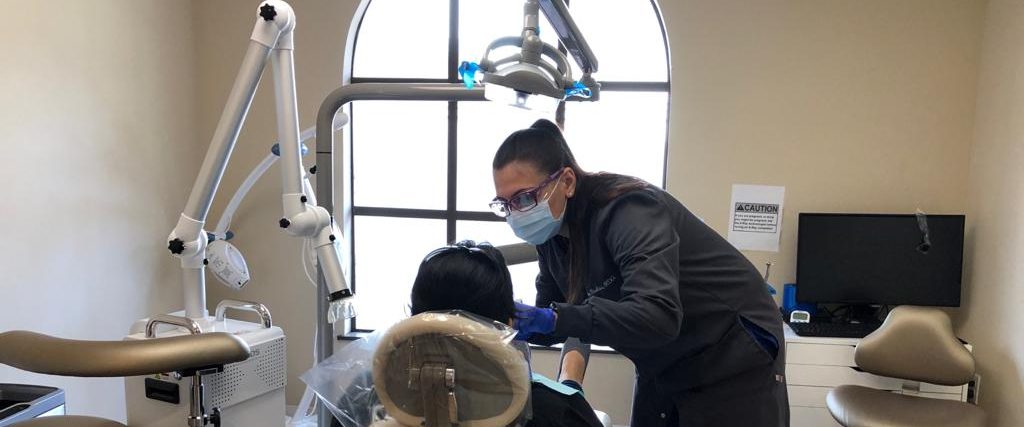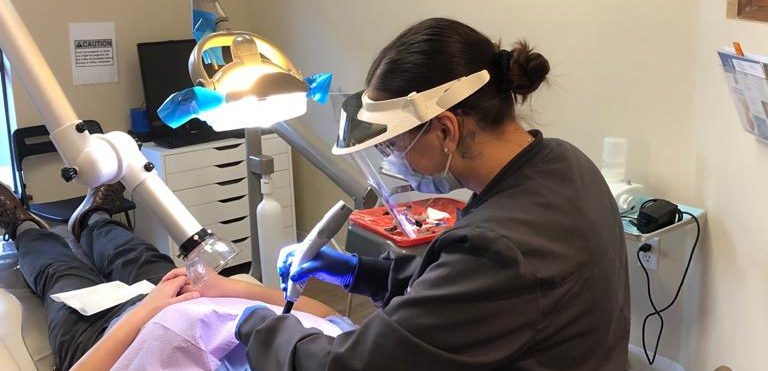Date : 15/08/2020
Even when you try to take good care of your teeth, you may find yourself with mouth problems that just won’t go away. In some cases, improving your dental hygiene can alleviate your symptoms. Others, however, require professional treatment.
So, how do you tell the difference?
Many people are very nervous about going to the dentist. They may be concerned about the pain of treatment. Some may feel a little embarrassed if they haven’t been taking as good care of their teeth as they should. And to make matters worse, some people are concerned about the cost.
The Most Common Mouth Problems
While many mouth problems will require a trip to your dentist or doctor, you can do a lot to relieve pain in the meantime. From jaw pain to gum soreness, let’s take a look at some ways you can improve your oral health. And if it turns out a dental visit is necessary, you’ll want to know some of your options beforehand.
Toothache
Toothaches are one of the world’s universal mouth problems. The cause of your toothache could be a cavity that needs fixing or a gum infection that requires treatment. And there are some common toothache causes you can avoid.
However, if your pain persists for more than a day, you may want to make your dental appointment earlier than usual. That way, your dentist can diagnose the cause and ensure that it doesn’t get any worse.
Until your appointment date, you can take some measures to reduce the pain, however.
Cavities
Cavities are one of the most common mouth problems for both children and adults. Tooth decay causes holes in your teeth. That, in turn, can result in pain and sensitivity. If untreated, you can easily get an infection and ultimately suffer from tooth loss.
Almost half of children have cavities, and adults can get them too. You should learn how to spot cavities before they become an infected tooth.
Fillings will prevent your teeth from decaying further. And you don’t have to worry. You don’t have to endure ugly and potentially toxic amalgam fillings that make your teeth look gray. Composite fillings – also known as tooth-colored fillings – are more common than ever. Best of all, they’re also mercury-free.
Broken teeth
Although our teeth are generally very durable, breaking or chipping a tooth is a common dental issue. Your teeth can break due to decay. And an injury to the mouth can often cause a chipped tooth.
Luckily you have many options for treating a broken tooth. Your dentist can apply a dental crown that makes your tooth look like new.
For chipped teeth, you can choose tooth bonding. Your dentist can apply dental bonding. This composite resin adheres to teeth and will make them look good again.
You can also break a tooth when chewing on hard foods. Many people who grind their teeth (known as bruxism) often find they break their teeth easily.
If you’ve broken a tooth – or teeth – because of grinding, you may want to choose to get them crowned or even replace with implants. However, to prevent any additional breakage, you should see your dentist about night guards.
These handy devices can spare you from further mouth problems from bruxism.
TMJ pain
Speaking of bruxism, TMJ pain – or pain in the temporal mandibular junction — is another one of the common mouth problems that plague many adults. TMJ pain can result from grinding your teeth in your sleep. It can also stem from a general health problem, like Sjogren’s Syndrome or Fibromyalgia.
You should see your dentist if you find yourself with TMJ pain. She can examine you and determine the cause of your discomfort.
If bruxism is the cause of your pain, she can suggest a plan of treatment. And if it underlies another health condition, she can work with your primary health care provider to alleviate the pain and help prevent any further damage to your teeth.
Sometimes, pain in your TMJ is caused by a misaligned jaw. A poorly aligned jaw can even disrupt proper neurological signaling, so in this case, you’ll want to see your dentist if it persists.
While it doesn’t seem like a critical issue, TMJ disorder can also cause headaches and pain in your ears and neck. TMJ pain can become a real quality of life issue.
Crooked teeth or gap teeth
Most people think of crooked teeth as a cosmetic issue only. However, it can cause mouth problems down the line.
Crooked teeth are harder to clean properly, and flossing can be a nightmare. While you may not need to visit your dentist right away if you have crooked teeth, you should consider asking about potential solutions.
If your teeth have minor imperfections that bring you down, you may be a good candidate for dental recontouring. This process can improve the appearance of your teeth without braces.
And even adults can consider braces for their crooked teeth. Dental technology has made some serious advances in recent years. Consider Invisalign braces, for example. These clear plastic aligners can improve the look and function of your teeth without making you self conscious about your appearance.
And here’s the best part:
You can remove them when you eat and when you clean your teeth. That means you won’t have to forgo some of your favorite foods. And they may not be as expensive as you thought.
Halitosis
Halitosis – or bad breath – is one of the most common mouth problems people suffer from. And it’s not so much a condition as it is a symptom.
There are several different causes of halitosis. It may simply be a matter of poor oral hygiene or poor food choices. Luckily, these are factors you can take in hand yourself.
However, bad breath could also mean you have more severe mouth problems, like periodontal disease. It can even be a symptom of a serious disease, such as diabetes.
One reason you should visit your dentist for bad breath is that the underlying condition causing your halitosis may require treatment. But you won’t know until you consult your dentist.
Until you can see your dentist, you may want to try a few techniques to see some improvement. You can reduce the oral bacteria in your mouth and add cleaning your tongue to your routine.
Gum disease
Gum disease is one of the most common mouth problems, especially in older adults. Not only can gum disease result in bad breath and tooth loss, but it can also even increase your risk of more serious conditions.
You might wonder what risks.
Researchers have found a clear association between gum disease and heart disease. Gum disease may increase your risks by as much as 20 percent.
Gum disease can even result in an increased risk of diabetes and cancer.
That sounds dire – and it is. But luckily treatment is available. That’s why your dentist stresses a rigorous brushing and flossing routine you can follow. And along with increasing your effects to improve your oral health routine, you should see your dentist.
Gum disease can even affect your unborn child. Many women aren’t aware of their risk for pregnancy gingivitis. Hormonal changes in pregnancy can often result in gum problems. And these infections can spread to your baby.
Don’t be embarrassed. Gingivitis and periodontal disease can stem from a number of factors beyond your control.
Other conditions can also result in gum disease, include your medications, family history, or the strength of your immune system. What’s important is to receive treatment as soon as possible.
Yellow teeth
You can have perfectly healthy teeth and the best oral care habits you can muster and still end up with yellow teeth. Having mouth problems when you’re so diligent doesn’t seem fair.
You may have stained teeth from coffee, tea, wine, or tobacco use. They call these “extrinsic stains,” because they’re caused by external factors.
You can also get yellow teeth from medications, including overexposure to fluoride or using your asthma medication. In fact, sometimes your yellow teeth may just be genetic. We call these “intrinsic stains,” and they’re a lot harder to remove because they form inside the tooth.
In the case of extrinsic staining, whitening treatments may go a long way in improving the look of your teeth. You’ll find a plethora of over-the-counter dental preparations – from toothpaste to rinses to trays. You may want to talk to your dentist about getting professional whitening treatments if you’re not happy with the results.
The benefit of going through your dental provider is that you’ll know the procedure is perfectly safe for your teeth.
For intrinsic stains, you may want to consider veneers. These thin ceramic coatings can hide discolorations and chips. You’ll love your smile after porcelain veneers.
Smoker’s teeth
Smoker’s teeth aren’t just one of the common mouth problems. In fact, it’s the other way around. Smoking is the cause of many mouth problems. And those it doesn’t cause, it makes worse.
Smoking can increase your chances of gum disease, along with all the ugly yellow teeth and staining that occurs.
While everyone you talk to will recommend that you quit immediately, anyone who smokes knows it isn’t always as simple as it sounds. And even if you do quit, you’ll still want to reverse the damage you’ve caused to your teeth and gums.
So, whether you’ve quit and want to improve your smile, or haven’t quit yet and want to reduce the damage, you can take action now.
Make sure you become diligent when it comes to oral hygiene. You should brush your teeth twice a day. You may find that an electric toothbrush makes this easier and improves your results.
And along with preventing or treating any gum disease from smoking, your dentist can provide cosmetic services such as tooth whitening or veneers. What a great way to reward yourself for quitting smoking once and for all!
Enamel erosion
Some common mouth problems include sensitivity to hot or cold foods or even textures. That’s usually because of enamel erosion. Once your enamel wears down, your teeth can easily chip, crack, or stain.
You may even see indented “cups” on the surface of your teeth. Rough edges or irregular coloration or texture on your teeth also serve as signs your enamel has eroded.
While you may not feel you need to visit the dentist immediately in this case, you don’t want to put it off. Eroded enamel can lead to increased sensitivity, even pain when eating. It also means your teeth will decay and break much more easily.
Luckily, your dentist can improve your dental outlook. Tooth bonding provides a thin covering that will help protect your teeth. If the damage is too severe, however, your dentist can provide a crown that restores the look and function of the damaged tooth.
Meanwhile, you can prevent further erosion and improve the strength of your teeth with a few commonsense steps to remineralize your teeth.
Missing teeth
Tooth loss can be one of life’s most embarrassing mouth problems. You may experience tooth loss from decay, smoking, or poor oral hygiene. Tooth loss can also occur due to an injury or bruxism.
If you have lost teeth, there’s no need to suffer the embarrassment for long. Your dentist has many ways to restore your smile. The fact is, you may find it looks better than ever.
You can choose from several tooth replacement options if you lose a tooth or even several teeth. Some people opt for dentures to replace a number of lost teeth. Partial dentures can also help fill the gaps due to tooth loss.
You may want to opt for a dental bridge. It provides a porcelain tooth between two healthy teeth. The healthy teeth get crowns, which can improve their appearance as well.
Your dentist can use many different types of dental implants too. Many people suffering from tooth loss opt for implants. If the underlying bone is healthy, you may be an excellent candidate for this procedure.
The benefit of implants vs. dentures is that you can receive temporary implants on the first visit. Although dentures are less expensive, they can prove uncomfortable and limit your lifestyle. They can also affect your speech.
Mouth ulcers
Mouth ulcers and mouth sores can result from a wide range of causes. As symptoms of several diseases – from a simple case of thrush to oral cancer – mouth sores are one of the common mouth problems you shouldn’t ignore.
A history of cold sores may mean you can see if it resolves itself in a week or two. However, if you have other symptoms, such as a coated tongue, you should see your dentist or primary care provider.
Thrush is a common fungal infection of the mouth, and you should have it treated right away.
Your dentist can provide an examination to rule out oral cancer during your regular exam. However, if you have additional symptoms, such as loose teeth or mouth pain for no discernable reason, see your dentist.
Other symptoms can include ear pain, bumps inside your mouth, and difficulty swallowing. If you suffer from these, book an appointment with your dentist right away.
Which Mouth Problems Require a Dental Visit?
The answer to this question is — all of them. However, some of these mouth problems are good candidates for home care before your annual checkup. You may feel that they can wait for your regularly scheduled appointment.
However, a few can be more easily resolved the sooner you get treatment. In fact, some should be treated right away before the condition leads to more painful problems.
There’s no reason to be embarrassed or fear a visit to your dentist. She has undoubtedly seen it all. And there’s no reason you should have to hide your smile or live in pain. Schedule an appointment and put your mouth problems to rest.




